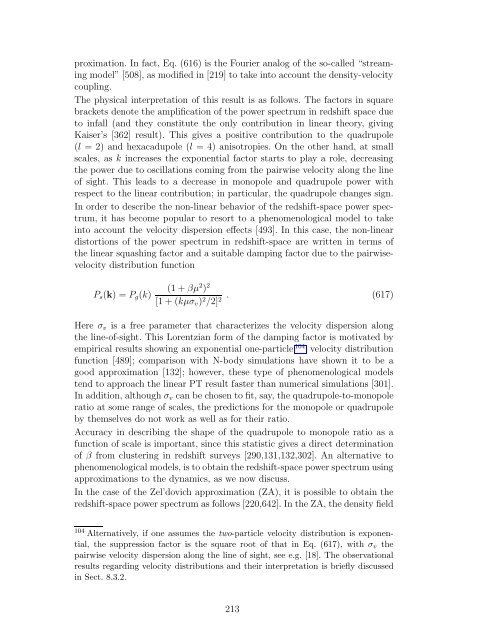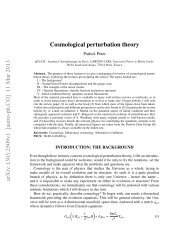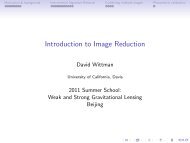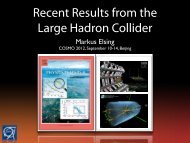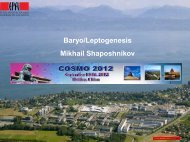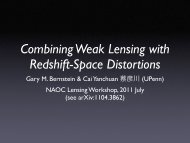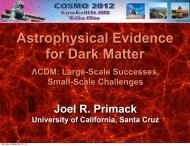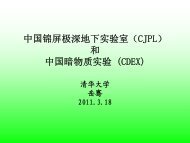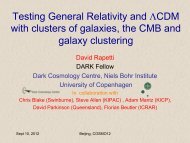Large-Scale Structure of the Universe and Cosmological ...
Large-Scale Structure of the Universe and Cosmological ...
Large-Scale Structure of the Universe and Cosmological ...
You also want an ePaper? Increase the reach of your titles
YUMPU automatically turns print PDFs into web optimized ePapers that Google loves.
proximation. In fact, Eq. (616) is <strong>the</strong> Fourier analog <strong>of</strong> <strong>the</strong> so-called “streaming<br />
model” [508], as modified in [219] to take into account <strong>the</strong> density-velocity<br />
coupling.<br />
The physical interpretation <strong>of</strong> this result is as follows. The factors in square<br />
brackets denote <strong>the</strong> amplification <strong>of</strong> <strong>the</strong> power spectrum in redshift space due<br />
to infall (<strong>and</strong> <strong>the</strong>y constitute <strong>the</strong> only contribution in linear <strong>the</strong>ory, giving<br />
Kaiser’s [362] result). This gives a positive contribution to <strong>the</strong> quadrupole<br />
(l = 2) <strong>and</strong> hexacadupole (l = 4) anisotropies. On <strong>the</strong> o<strong>the</strong>r h<strong>and</strong>, at small<br />
scales, as k increases <strong>the</strong> exponential factor starts to play a role, decreasing<br />
<strong>the</strong> power due to oscillations coming from <strong>the</strong> pairwise velocity along <strong>the</strong> line<br />
<strong>of</strong> sight. This leads to a decrease in monopole <strong>and</strong> quadrupole power with<br />
respect to <strong>the</strong> linear contribution; in particular, <strong>the</strong> quadrupole changes sign.<br />
In order to describe <strong>the</strong> non-linear behavior <strong>of</strong> <strong>the</strong> redshift-space power spectrum,<br />
it has become popular to resort to a phenomenological model to take<br />
into account <strong>the</strong> velocity dispersion effects [493]. In this case, <strong>the</strong> non-linear<br />
distortions <strong>of</strong> <strong>the</strong> power spectrum in redshift-space are written in terms <strong>of</strong><br />
<strong>the</strong> linear squashing factor <strong>and</strong> a suitable damping factor due to <strong>the</strong> pairwisevelocity<br />
distribution function<br />
Ps(k) = Pg(k)<br />
(1 + βµ 2 ) 2<br />
[1 + (kµσv) 2 . (617)<br />
/2] 2<br />
Here σv is a free parameter that characterizes <strong>the</strong> velocity dispersion along<br />
<strong>the</strong> line-<strong>of</strong>-sight. This Lorentzian form <strong>of</strong> <strong>the</strong> damping factor is motivated by<br />
empirical results showing an exponential one-particle 104 velocity distribution<br />
function [489]; comparison with N-body simulations have shown it to be a<br />
good approximation [132]; however, <strong>the</strong>se type <strong>of</strong> phenomenological models<br />
tend to approach <strong>the</strong> linear PT result faster than numerical simulations [301].<br />
In addition, although σv can be chosen to fit, say, <strong>the</strong> quadrupole-to-monopole<br />
ratio at some range <strong>of</strong> scales, <strong>the</strong> predictions for <strong>the</strong> monopole or quadrupole<br />
by <strong>the</strong>mselves do not work as well as for <strong>the</strong>ir ratio.<br />
Accuracy in describing <strong>the</strong> shape <strong>of</strong> <strong>the</strong> quadrupole to monopole ratio as a<br />
function <strong>of</strong> scale is important, since this statistic gives a direct determination<br />
<strong>of</strong> β from clustering in redshift surveys [290,131,132,302]. An alternative to<br />
phenomenological models, is to obtain <strong>the</strong> redshift-space power spectrum using<br />
approximations to <strong>the</strong> dynamics, as we now discuss.<br />
In <strong>the</strong> case <strong>of</strong> <strong>the</strong> Zel’dovich approximation (ZA), it is possible to obtain <strong>the</strong><br />
redshift-space power spectrum as follows [220,642]. In <strong>the</strong> ZA, <strong>the</strong> density field<br />
104 Alternatively, if one assumes <strong>the</strong> two-particle velocity distribution is exponential,<br />
<strong>the</strong> suppression factor is <strong>the</strong> square root <strong>of</strong> that in Eq. (617), with σv <strong>the</strong><br />
pairwise velocity dispersion along <strong>the</strong> line <strong>of</strong> sight, see e.g. [18]. The observational<br />
results regarding velocity distributions <strong>and</strong> <strong>the</strong>ir interpretation is briefly discussed<br />
in Sect. 8.3.2.<br />
213


